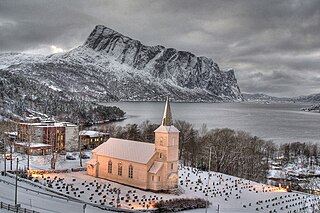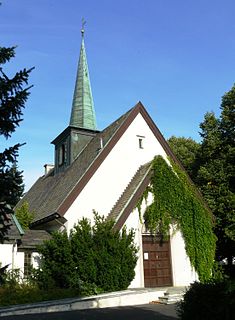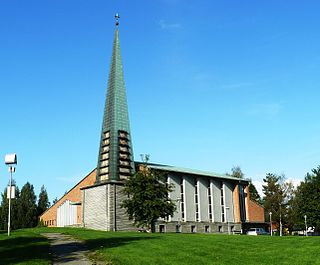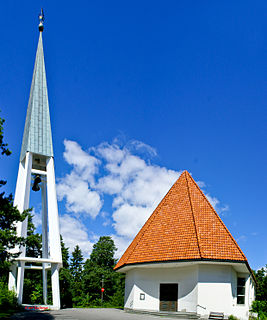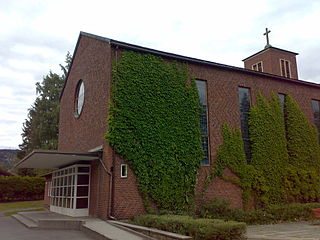| Manglerud Church | |
|---|---|
| Manglerud kirke | |
 | |
| Coordinates: 59°53′46.968″N10°48′38.779″E / 59.89638000°N 10.81077194°E | |
| Location | Byggveien 10, Manglerud, Oslo, |
| Country | Norway |
| Denomination | |
| Churchmanship | Evangelical Lutheran |
| Website | kirken.no/manglerud |
| History | |
| Status | Parish church |
| Consecrated | 1963 |
| Architecture | |
| Functional status | Active |
| Architect(s) | Carl Corwin |
| Specifications | |
| Capacity | 600 seats |
| Administration | |
| Parish | Manglerud |
| Deanery | Søndre Aker |
| Diocese | Diocese of Oslo |
Manglerud Church is a church in Oslo, Norway. The church was consecrated in December 1963. It is a parish church for Manglerud congregation. 400 seats, in addition to an adjacent church hall with 200 seats, as well as a smaller hall with 50 seats. There are also a small chapel, a baptismal sacristy and a youth activity room attached to the building. Manglerud Church is located above and on the south side of the E 6 highway and the subway at Ryen Station. It is easily visible with its high, steep ceilings and a slender, separate bell tower. [1] [2]

Oslo is the capital and most populous city of Norway. It constitutes both a county and a municipality. Founded in the year 1040 as Ánslo, and established as a kaupstad or trading place in 1048 by Harald Hardrada, the city was elevated to a bishopric in 1070 and a capital under Haakon V of Norway around 1300. Personal unions with Denmark from 1397 to 1523 and again from 1536 to 1814 reduced its influence. After being destroyed by a fire in 1624, during the reign of King Christian IV, a new city was built closer to Akershus Fortress and named Christiania in the king's honour. It was established as a municipality (formannskapsdistrikt) on 1 January 1838. The city functioned as a co-official capital during the 1814 to 1905 Union between Sweden and Norway. In 1877, the city's name was respelled Kristiania in accordance with an official spelling reform – a change that was taken over by the municipal authorities only in 1897. In 1925 the city, after incorporating the village retaining its former name, was renamed Oslo.

Norway, officially the Kingdom of Norway, is a Nordic country in Northwestern Europe whose territory comprises the western and northernmost portion of the Scandinavian Peninsula; the remote island of Jan Mayen and the archipelago of Svalbard are also part of the Kingdom of Norway. The Antarctic Peter I Island and the sub-Antarctic Bouvet Island are dependent territories and thus not considered part of the kingdom. Norway also lays claim to a section of Antarctica known as Queen Maud Land.
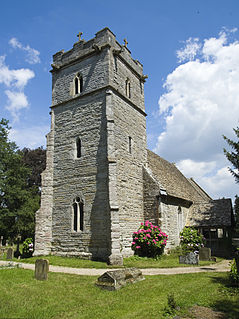
A parish church in Christianity is the church which acts as the religious centre of a parish. In many parts of the world, especially in rural areas, the parish church may play a significant role in community activities, often allowing its premises to be used for non-religious community events. The church building reflects this status, and there is considerable variety in the size and style of parish churches. Many villages in Europe have churches that date back to the Middle Ages, but all periods of architecture are represented.
The 15 m high wall at the choir contains stained glass created by Sigurd Winge, it depicts "The Cross - from suffering to victory". In the choir hangs two knotted tapestries, created by Else Poulson. The pulpit and baptismal font are designed by drawings by architect Carl Corwin.
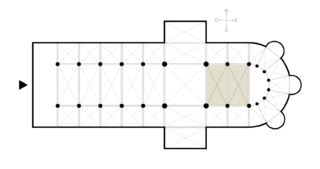
A choir, also sometimes called quire, is the area of a church or cathedral that provides seating for the clergy and church choir. It is in the western part of the chancel, between the nave and the sanctuary, which houses the altar and Church tabernacle. In larger medieval churches it contained choir-stalls, seating aligned with the side of the church, so at right-angles to the seating for the congregation in the nave. Smaller medieval churches may not have a choir in the architectural sense at all, and they are often lacking in churches built by all denominations after the Protestant Reformation, though the Gothic Revival revived them as a distinct feature.

Sigurd Winge was a Norwegian painter and visual artist who worked with various media. He was born in Germany, and the father of actor Stein Winge. Among his works are Terror from 1942 and Kvinnehode (Flyalarm) from 1944/1945. He was a professor at the Norwegian National Academy of Fine Arts from 1969 to 1970.

Tapestry is a form of textile art, traditionally woven by hand on a loom. Tapestry is weft-faced weaving, in which all the warp threads are hidden in the completed work, unlike cloth weaving where both the warp and the weft threads may be visible. In tapestry weaving, weft yarns are typically discontinuous; the artisan interlaces each coloured weft back and forth in its own small pattern area. It is a plain weft-faced weave having weft threads of different colors worked over portions of the warp to form the design.
The church organ is a pipe organ with 32 voices. The three church bells are named "Joy," "Thank You," and "Prayer." They were cast at Olsen Nauen Bell Foundry and the weight are respectively. 240 kg, 480 kg and 850 kg. They have each engraved their own verse from 1 Thessalonians 5, 16-18: "Always be happy", "Pray forever" and "Thank you for everything". [1] [2] [3] [4]

The pipe organ is a musical instrument that produces sound by driving pressurized air through the organ pipes selected from a keyboard. Because each pipe produces a single pitch, the pipes are provided in sets called ranks, each of which has a common timbre and volume throughout the keyboard compass. Most organs have many ranks of pipes of differing timbre, pitch, and volume that the player can employ singly or in combination through the use of controls called stops.

The Olsen Nauen Bell Foundry is a Norwegian bell foundry located in the municipality of Tønsberg. The foundry was established in 1844 by Ole Olsen, and it is headed today by the sixth generation of the Olsen Nauen family. The company is based at the Nauen farm in Sem and is Norway's only bell foundry.
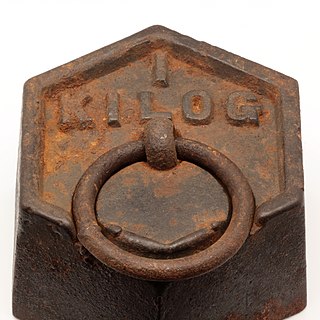
The kilogram is the base unit of mass in the metric system, formally the International System of Units (SI), having the unit symbol kg. It is a widely used measure in science, engineering, and commerce worldwide, and is often simply called a kilo in everyday speech.
Manglerud Church is listed by the Norwegian Directorate for Cultural Heritage. [5]

The Directorate for Cultural Heritage is a government agency responsible for the management of cultural heritage in Norway. Subordinate to the Norwegian Ministry of the Environment, it manages the Cultural Heritage Act of June 9, 1978. The directorate also has responsibilities under the Norwegian Planning and Building Law.



